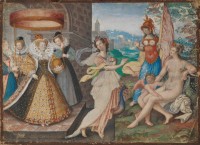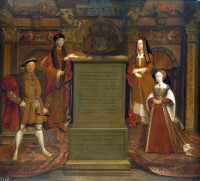 In July of 2012, a previously unknown miniature depicting Queen Elizabeth I as the central figure in a reimagining of the Judgment of Paris sold at Christie’s for $453,833, five times its pre-sale estimate. It was purchased by an art dealer who arranged for its sale to the National Portrait Gallery. Although the NPG has nine portraits of Queen Elizabeth, this is the first one that has an allegorical theme which makes the little piece a hugely significant addition to the gallery’s permanent collection.
In July of 2012, a previously unknown miniature depicting Queen Elizabeth I as the central figure in a reimagining of the Judgment of Paris sold at Christie’s for $453,833, five times its pre-sale estimate. It was purchased by an art dealer who arranged for its sale to the National Portrait Gallery. Although the NPG has nine portraits of Queen Elizabeth, this is the first one that has an allegorical theme which makes the little piece a hugely significant addition to the gallery’s permanent collection.
The postcard-sized (4.5 × 6.25 inches) chalk, gouache and gold on vellum painting was found during a house clearance in south-east England. It’s very rare to find a work of such high quality that has never been published before and allegorical images of Queen Elizabeth I are rare enough as it is. The style of the clothing dates it to around 1590.
The piece is unsigned, but various features and its high quality mark it as the work of Isaac Oliver, a French-born Huguenot miniaturist who was the greatest student of court painter Nicholas Hilliard, known for his miniature portraits of royalty. It’s a re-working of Elizabeth I and the Three Goddesses, a full-sized painting in the Royal Collection at Hampton Court from 1569 originally attributed to Hans Eworth but now thought to have been painted by Joris Hoefnagel.
 In both paintings, Elizabeth holds the Golden Apple of Discord while the three goddesses — Juno, Minerva and Venus — vying for it back away. Elizabeth is both Paris, the prince of Troy who is supposed to assign the apple to the most beautiful of the three, and the ultimate recipient of it. She spurns the discord the apple is intended to cause and instead just keeps it, making her the most beautiful of them all and the bringer of peace. In the Hampton Court painting, Juno appears to be beckoning at her, a suggestion that the Queen follow her into marriage, perhaps, but by the time of the miniature 20 years later, Juno’s extended arm appears to be blocking Venus instead. Elizabeth was no longer susceptible, the allegory suggests, to the blandishments of love and marriage.
In both paintings, Elizabeth holds the Golden Apple of Discord while the three goddesses — Juno, Minerva and Venus — vying for it back away. Elizabeth is both Paris, the prince of Troy who is supposed to assign the apple to the most beautiful of the three, and the ultimate recipient of it. She spurns the discord the apple is intended to cause and instead just keeps it, making her the most beautiful of them all and the bringer of peace. In the Hampton Court painting, Juno appears to be beckoning at her, a suggestion that the Queen follow her into marriage, perhaps, but by the time of the miniature 20 years later, Juno’s extended arm appears to be blocking Venus instead. Elizabeth was no longer susceptible, the allegory suggests, to the blandishments of love and marriage.
The 1569 painting was the first allegorical portrait she had made and the Judgment of Paris was a particularly pointed theme for Elizabeth. Her mother, Anne Boleyn, had been regaled with pageants on that same subject during her coronation procession which took place in May of 1533, when she was already five months pregnant with the future Queen Elizabeth.
The marriage of Henry VIII and Catherine of Aragon had been declared null and void by Archbishop of Canterbury Thomas Cranmer on May 23rd; Cranmer declared Henry and Anne’s wedding (there was a secret ceremony in December followed by a public one in January after she got pregnant) valid on May 28th. The next day coronation ceremonies began. After two days of barge trips and ceremonial processions, Anne Boleyn was crowned Queen Consort of England on June 1st, 1533.
There are two main accounts of the coronation, one by Edward Hall who was one of the organizers of the festivities, published in a 1548 two-volume history of Tudor kings known as Hall’s Chronicle, and the other a pamphlet by Wynkin de Worde printed in 1533 entitled The Noble Tryumphaunt Coronacyon of Quene Anne, Wyfe unto the Noble Kynge Henry the VIII.
Most of these pageants were mythological allegories involving Greco-Roman deities and heavy-handed symbolism about Anne’s great beauty, chastity (really), fertility and general worthiness to be Queen, a matter by no means universally accepted at this time since Catherine’s spurning and the break with Rome were enormously controversial fresh wounds. Here’s Hall’s description of the Judgment of Paris pageant:
And so roade to the lytle Conduyte, where was a riche pageaunt full of melodye and song, in which pageaunt were Pallas, Iuno, and Venus, and before them stode Mercury, whiche in the name of the three goddesses gave unto her a balle of gold, devided into three, signifying three gifts which these three goddesses gave to her, that is to say, wysedome, ryches, and felicitie.
Here’s Wynkin de Worde’s description of same:
And so her grace passed a lytell further and at the lesser Condyt was a costly and a ryche pagent whereas was goodly armonye of musyke and other mynstrels with syngyng. And within that pagent was fyve costly seates wherin was set these fyve personages that is to wete Juno, Pallas, Mercury and Venus and Parys hauyng a ball of golde presentyng it to her grace with certayne verses of great honour and chyldren syngyng a balade to her grace and prayse to all her ladyes.
Those verses of great honour were written by Nicholas Udall and John Leland who had been enlisted to create English and Latin poems to accompany the pageants and tableaux vivants along the route of the coronation procession from the Tower of London to Westminster Palace on May 30th, 1533.
Udall and Leland’s verses about the Judgment of Paris tableau:
The proud goddesses assaulted great Jove with their immoderate entreaties, asking him for the little golden prize bestowed on consummate beauty. Therefore at the behest of his Dictys-born father [Jupiter], the child of African Atlas [Mercury] flew through the clouds as a companion to the goddesses, and gave the apple to comely Paris as he was pasturing his flocks in the groves of Phrygia’s Mt. Ida, and now the Dardanian [Trojan] shepherd, shaking off his easy sleep, grasped it in his hand, so he might quickly employ his keen judgment to bestow it on a goddess of especial beauty for her enjoyment. Meanwhile the consort of supreme Jove, impatient of delay, demanded this prize of conquering beauty, promising Paris proud realms. Pallas offered her arts, if the prize for comeliness were granted her. Venus, promising him the beds he desired, staked her claim on the little reward of the golden apple. Straightway Paris sweetly smiled, and, casting around his delightful eyes and pointing at Anne, said, “Behold, you may see a woman supreme in all respects, and deserving to carry off even three hundred apples thanks to the goodliness of her virtues. No small gift must be given to Anne. The scepter awaits her, as does the crown, a fitting reward for her virtues. He who bid you come here in search of prizes of beauty, goddesses, set a trap for you, and when he sent you here the Thunderer wanted you to be suffused with no small amount of blushing. You take the apple, Venus, and now all you goddesses may go back to high heaven.”
Many men have told me that Dardanian Paris was an elegant witness to beauties and to all comeliness when, a proud shepherd, he was leading his snow-white flocks over lofty Ida, and with his thrice-fair hand gave the golden apple to Venus, to the indignation of Minerva and Jove’s sister, until comely Anne came along. Thinking this over frequently, I could not see the point of these amazing mysteries until you, divine Venus, came down from heaven on a quick course to us oceanic English and cheerfully gave the golden apple to a woman fairer than yourself, Anne, whose pretty head will soon be encircled by the beauty of a crown gleaming with jewels.
And whose pretty little neck would soon after that be separated from her pretty head.
 Elizabeth’s embrace of this particular allegory was a recognizable and highly pointed tribute to her mother. Instead of avoiding the tendentious matter of the legitimacy of Anne’s marriage and thus her own legitimacy as her father’s heir, she chose to associate herself with her mother’s reign as queen of England and reclaim her place as the daughter of royalty on both sides. In the Hampton Court painting, Elizabeth is wearing St. Edward’s Crown, the same imperial crown that Anne was crowned with in 1533.
Elizabeth’s embrace of this particular allegory was a recognizable and highly pointed tribute to her mother. Instead of avoiding the tendentious matter of the legitimacy of Anne’s marriage and thus her own legitimacy as her father’s heir, she chose to associate herself with her mother’s reign as queen of England and reclaim her place as the daughter of royalty on both sides. In the Hampton Court painting, Elizabeth is wearing St. Edward’s Crown, the same imperial crown that Anne was crowned with in 1533.
She had Elizabeth I and the Three Goddesses hung in Whitehall Palace near the 1537 Hans Holbein mural of the Tudor dynasty Henry had commissioned when Elizabeth’s half-brother Edward was born. That version of the Tudor dynasty featured King Henry VII back left, King Henry VIII front left, his mother Elizabeth of York back right and Jane Seymour, Henry’s his third wife and mother of his only son, front right. Nobody else made the cut. In this mural her father had tried to scrub Anne and Elizabeth out of the Tudor line; Elizabeth put them both back through the Judgment allegory.
Elizabeth was queen regnant, not queen consort, so as much as the allegory recognized Elizabeth’s matrilineal royalty, it also made a stronger statement about Elizabeth’s status as undisputed ruler. Unlike her mother, she doesn’t receive the apple from Paris or even Venus; she takes the man out of the equation altogether and appoints herself the winner. The three goddesses don’t just accept her as one of their own as they did Anne Boleyn; they acknowledge her as dominant. Juno even loses a shoe in her haste to step back from Elizabeth Regina. The apple she holds is the sovereign’s orb, although in the miniature it doesn’t have the cross and straps of the official orb, it is still a gigantic golden orb indicative of her majesty.
Both the miniature and the Hampton Court painting will go on display at the NPG’s new exhibition Elizabeth I & Her People which will run from October 10th, 2013, through January 5th, 2014. The exhibit will include many portraits of Elizabeth, her court, explorers, ambassadors along with merchants, financiers, lawyers, artists and others who were part of the diverse social classes on the rise in Elizabethan England. Believe it or not, the gallery had already arranged the loan of the larger painting before the miniature appeared on the market. The timing of the find could not have been more fortuitous for the National Portrait Gallery.